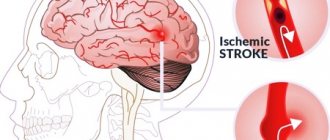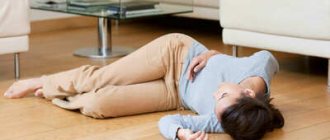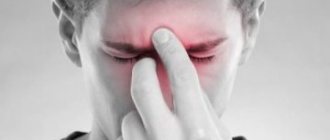The ancient Roman poet Publilius Syrus rightly noted that “the fear of death is worse than death itself.” Any person suffering from vegetative-vascular dystonia will easily agree with him, and will even make a small amendment to the statement: the fear of death with VSD is so much worse than death itself that all life seems like useless suffering. VSDers are so tired of their own heads and uncontrolled phobias that they sometimes envy animals and their blissful ignorance.
From the outside, such behavior may seem strange, illogical, unhealthy (which is to some extent justified). A person who has never encountered VSD, neuroses and panic states is simply not able to let through all the horror that a VSD sufferer experiences every day. “Stop it, I got it!” It would be better to go and have a walk with friends than to sit within four walls and fill your head with nonsense!” - this is what VSD residents regularly hear from their households. And the helplessness only intensifies.
“No one can save you: neither doctors, nor loved ones. Nobody believes me!
Why does the fear of death arise in VSD?
Fear of sudden death - thanatophobia - is not such a rare phenomenon. This phobia has manifested itself in people at all times, and not only among VSD people. The causes of thanatophobia have not been fully studied, but it has already been revealed that an obsessive fear of death occurs in overly impressionable, suspicious people, those who suffer from hypochondria and think a lot about the future.
The trigger for the development of a phobia can be the tragic death of a friend or loved one, a midlife crisis with a reassessment of life priorities, or an excess of negative information from the Internet or television.
The fear of death with VSD usually starts during the first panic attack in life. Even if the patient’s psyche heroically withstands an unfamiliar state, the thought is forever deposited in the subconscious: I almost died once... Many VSDs remember their first panic attack as a tragic event (accident, fire, injury).
If a panic attack occurs for the first time in a teenager, it is especially difficult for him to adequately respond to this painful condition. After all, everything was fine just recently. Yes, my head was spinning, my pulse sometimes quickened, but it didn’t frighten me so much. And when the body suddenly trembled, as if pierced by electricity, the legs and arms became cold, and the heart beat in every vein and in the ears - the patient was not just scared, he succumbed to panic, completely immersed in the adrenaline that was walking through the blood. And the ambulance, encouraging me, said that at that age they don’t die.
Symptoms
Manifestations of the disorder vary from person to person. In most cases, an avoidant anxious behavior style is formed. If a person is afraid of dying from an illness, then trips to hospitals and constant examinations are typical. If fear is associated with an accident, then isolation and avoidance of public places occurs.
Symptoms of panic attacks and fear of death involve physical manifestations that occur suddenly. These include:
- trembling throughout the body;
- palpitations - a feeling that your heart will jump out of your chest;
- lack of air;
- increased sweating;
- chills or intense hot flash;
- sharp pain and heaviness in the chest;
- numbness of the limbs;
- dizziness;
- darkening of the eyes.
All these manifestations occur simultaneously, without an obvious external cause. This condition is scary. Often such an attack is mistaken for a heart attack or as a manifestation of another fatal disease. A person perhaps realizes for the first time that he can die at any moment. This fear consumes all his thoughts, which negatively affects his personal and professional life.
In people with a panicky fear of death, symptoms affect more than just the body. Behavior, habits, and attitude to life change. The following manifestations are characteristic:
- aggressiveness or irritability;
- increased anxiety;
- desire for loneliness;
- avoiding any situations that may involve risk;
- excessive sensitivity;
- passivity;
- conversations about the meaninglessness of current events;
- diffidence.
A person at the initial stage of development of a phobia realizes that there are no real reasons for panic. He tries to cope with the feeling of fear on his own. But life in constant tension also leads to gastrointestinal disorders, sleep disorders, and arterial crises.
How does a phobia of death develop in VSD?
Remaining in the subconscious, the obsessive fear of sudden death was reinforced every day, every month and year - either someone’s death would be shown on the news, or a tragedy would happen in the family of friends, or the patient himself would begin to grind in his memory all his feelings and thoughts during the crisis. Subsequent panic attacks - and they no longer leave you alone - only add fuel to the fire.
Each time the VSD member fears more and more for his life. He turns into a hypochondriac: he begins to read tons of information about heart disease, attacks, strokes, “try on” the symptoms for himself and, surprisingly, find similarities. Now he considers any burning sensation behind the sternum to be the beginning of a heart attack. Stumbling over a threshold means a stroke, loss of coordination. Periodically, the patient even checks himself for the presence of a stroke: he raises both arms, smiles in front of the mirror - God forbid he notices some kind of asymmetry.
Measuring your heart rate has now become commonplace - like brushing your teeth, only more often. Much more often. Instead of human friends - a tonometer, Corvalol, Anaprilin, bookmarks on medical forums. Therapists, paramedics, and household members can refute the patient’s suspicions as much as they like. But VSD and obsessive thoughts about death are inseparable concepts.
Who is most susceptible to the disease?
In medical statistics, hypochondria occurs equally in men and women. Most often it appears at the age of 40-60 years, as well as in adolescence. In adolescents, this phenomenon is caused by hormonal surges, changes in the body and psychological state. Changes in appearance and character bother children and they often develop hypochondria. At such moments, they listen with special attention to the slightest discomfort. This leads to the fact that a slight tingling sensation can develop into acute pain.
It is also not uncommon for the disease to be detected in students. The presence of a heavy workload, constant stress and disruption of the usual daily routine can easily cause hypochondria. The disease subsides upon graduation.
The people most susceptible to this type of disease are emotional people. In addition to banal stress, the development of hypochondria is facilitated by flows of information about new diseases, statistics on people suffering from AIDS and oncology. Fear for one's health is the impetus for the development of a constant feeling of anxiety and concern for one's life.
How to overcome the fear of death with VSD
If dystonia is not a disease, then thanatophobia is a real mental disorder, and it requires action. The therapist is powerless here; we need a psychologist, and in severe cases, a psychiatrist who will prescribe anti-anxiety medications.
While the fear of sudden death has not yet taken on a severe form, VSD members can hotly discuss it on their forums, even make fun of each other. But if even some random user “dare” to make a joke or remark, they will attack in a crowd and peck you away.
After all, deep down in their souls, they understand perfectly well that they still haven’t coped - and, perhaps, they won’t cope anymore. Some may have the illusion of control over their phobias, but how colorfully it breaks on the next iceberg of a panic attack.
What does the obsessive fear of death lead to in VSD when it takes on a severe form?
- Obsessive-compulsive disorder, which torments the patient with its “rituals.” Example: a patient has a momentary thought that if he does not touch the exit door with his forehead three times, he will die in the evening. The thought is so obsessive that a person does not have a single chance to resist it. He goes and touches his forehead to the door. Okay, but what if this happens at work, at a bus stop, in a store in front of a window? Some find it funny, but others actually perform these rituals to the detriment of their own reputation!
- A person rearranges his life so as to keep pace with his phobia. He stops communicating with many friends, avoids contact with people, and practically does not leave the house: after all, death awaits on every corner.
- If a person is afraid that he will die from some fatal disease, then he can literally not leave the hospital and undergo endless examinations. In severe cases, a person is afraid to end up in a place that is difficult to reach for an ambulance, for example, outside the city.
- Everyday chores and work become an overwhelming burden, taking more and more energy. Man is unable to do simple things.
- Stress changes many organic functions, health deteriorates sharply, and panic attacks occur more often than usual. This stress causes chronic fatigue and depression.
Therefore, it is very important not to start the problem. And as soon as it appears, immediately contact a psychologist. The sooner you start working with a psychologist, the easier it will be to overcome the fear of sudden death.
Psychovegetative syndrome associated with anxiety (diagnostic and therapeutic issues)
About the article
17583
0
Regular issues of "RMZh" No. 23 dated November 29, 2006 p. 1696
Category: Neurology
Author: Vorobyova O.V. 1 1 Federal State Autonomous Educational Institution of Higher Education First Moscow State Medical University named after. THEM. Sechenov Ministry of Health of Russia (Sechenov University), Moscow, Russia
For quotation:
Vorobyova O.V. Psychovegetative syndrome associated with anxiety (issues of diagnosis and therapy). RMJ. 2006;23:1696.
Vegetative (vegetative-vascular) dystonia is a diagnostic category extremely often used by doctors. As a rule, most practitioners understand the term autonomic dystonia as psychogenic-induced multisystem autonomic disorders. However, it is unacceptable to use the term vegetative dystonia as a nosological diagnosis. At the same time, it is very useful to use this term when formulating a syndromic diagnosis, at the stage of clarifying the category of psychopathological syndrome associated with autonomic disorders. When analyzing the clinical manifestations of autonomic dystonia, it is advisable to separate psychopathological symptoms and associated autonomic disorders.
Autonomic disorders Autonomic disorders affect almost all functional systems of the body (Table 1). But patients often present complaints that are characteristic of any one functional system, based on their own or curtural ideas about the significance of a particular organ in the body. Most often, patients describe cardiovascular symptoms. Careful questioning of the patient will help to identify multisystem disorders, which is the most important diagnostic criterion for autonomic dystonia. It is also important for the doctor to evaluate not only the symptom that seems most important to the patient and put forward by him as the main complaint, but also the symptoms accompanying the current complaint. Autonomic symptoms may be associated with: • sleep disturbances (difficulty falling asleep, light sleep, waking up at night) • irritability in relation to normal life situations (for example, increased sensitivity to noise) • feeling of constant fatigue • impaired attention • changes in appetite • neuroendocrine disorders . The dynamics of autonomic disorders is also important for diagnosis. Autonomic complaints are very “mobile”: one symptom is replaced by another, the intensity of one or another symptom changes. “Mobility” of symptoms is one of the most characteristic features of vegetative dystonia. Psychopathological component of autonomic dystonia Mental disorders obligately accompany autonomic dysfunction. However, the type of mental disorder and its severity vary widely among different patients. Mental symptoms are often hidden behind a “façade” of massive autonomic dysfunction and are ignored by the patient and those around him. The doctor’s ability to “see” psychopathological symptoms in a patient, in addition to autonomic dysfunction, is decisive in diagnosis. Most often, autonomic dysfunction is associated with emotional and affective disorders: anxiety, depression, mixed anxiety-depressive disorder, phobias, hysteria, hypochondria. The leader among psychopathological syndromes associated with autonomic dysfunction is anxiety. Anxiety is a signal about threatening changes in the body or the external world, and in connection with this it plays an adaptive role; however, if it is expressed excessively, then, on the contrary, it interferes with normal life activities. The most familiar condition to everyone is the one that occurs when danger appears and is manifested by sweating of the palms, nervous tremors, and palpitations. Anxiety disorders are a group of syndromes characterized by excessive anxiety, intense fear, internal tension and/or somatic symptoms in the absence of a real threat situation (Table 2). Anxiety disorders are extremely common. About 50% of individuals in society have either isolated anxiety symptoms or syndromic depressive or anxiety disorders. Pharmacoeconomic studies indicate that a third of all treatment costs for mental illness in general are spent on treating anxiety. All these pathological conditions are characterized by both general and specific anxiety symptoms. Autonomic symptoms, mainly associated with increased sympathetic tone, are considered among the general anxiety symptoms. The most common general symptoms of anxiety are presented in Table 3. Specific symptoms of anxiety, relating to the type of formation and course of anxiety, determine the specific type of anxiety disorder (Table 4). Recent epidemiological studies have shown a high prevalence of patients with mild (subthreshold) anxiety disorders in the population. Subthreshold anxiety refers to two or more anxiety symptoms that are present simultaneously in an individual for at least two weeks and lead to social maladjustment. Individuals with subthreshold anxiety do not fully meet the criteria for any anxiety disorder. These patients do not have enough criteria (symptoms) to diagnose the disease. The main manifestation of the disease is nonspecific vegetative symptoms. Unfortunately, the presence of individual alarming symptoms in a patient is not considered by him and his environment as a pathological condition and is not a sufficient incentive to seek help from a doctor. At the same time, sub-anxiety states are fraught with potential danger. Without treatment, anxiety symptoms can persist, often worsening and reaching full-blown anxiety syndromes. Anxiety symptoms can be complicated by depression and other mental illnesses. It is natural that with the progression of the disease, mental symptoms of anxiety become de-actualized and progressive vegetative symptoms come to the fore in the clinical picture. Thus, the chronicity of the mental and autonomic components of PVS are parallel processes. Probably, “variable” vegetative symptoms of unknown origin for the patient and hypochondriacal fixation on them form a “vicious circle”. The chronicity of anxiety is greatly facilitated by inadequate and untimely treatment measures. A study of the quality of life in people with subsyndromal anxiety showed that in terms of parameters of professional and social activity, the decrease in their quality of life is comparable to patients with a full-blown anxiety disorder, and significantly worse compared to healthy individuals. For panic disorder, it has been shown that the full syndrome has a greater effect on personality functioning than rare panic attacks (at least one attack in the 6-month period before the start of the epidemiological survey), but patients with rare attacks have a significantly reduced quality of life, than a healthy population. These findings are not surprising, since similar data are available in populations with subthreshold depression and with mixed anxiety-depressive states. It is indisputable that due to such a significant prevalence in the population, subthreshold anxiety disorders reduce the social and professional activity of the general population more than syndromic anxiety disorders themselves. Thus, subthreshold anxiety disorders cause more harm to society than anxiety disorders that fully meet diagnostic criteria. It is important that subthreshold anxiety disorders have become the focus of research only in recent years. Meanwhile, diagnosis and treatment of subthreshold anxiety disorders reduces the incidence of full-blown anxiety syndromes in society. Therefore, even individual symptoms of anxiety require active therapeutic measures. Therapy of psycho-vegetative syndrome The so-called vegetotropic (anaprilin, proroksan, belloid, bellaspon, etc.) and vascular-metabolic (cinnarizine, vinpocetine, pentoxifylline, piracetam, cerebrolysin) drugs, previously widely used for the correction of vegetative disorders, are currently practically not used in due to their low efficiency. It is permissible to use only certain drugs (b-blockers, betahistine, sulbutiamine, etc.) as additional, symptomatic agents to correct the most significant symptoms for the patient. The therapeutic strategy must be built depending on the type of dominant disorder of the psychopathological component of the syndrome. Since autonomic dysfunction is most often associated with anxiety disorders, the leaders in the treatment of autonomic dystonia are drugs that have an anxiolytic effect. The choice of drug depends on the severity of the anxiety level and the duration of the disease. In cases of full-blown anxiety disorder, benzodiazepine anxiolytics have been the so-called first choice drugs for a long time. Benzodiazepines are still the best short-term treatment for anxiety. These drugs are quite easily tolerated and provide the fastest therapeutic effect. The most significant problem with the use of benzodiazepines is the development of addiction and dependence. Since these side effects are significantly dependent on the dose and duration of use, there has recently been a clear trend towards the use of low dosages and short courses of therapy, which usually do not exceed four weeks. For chronic anxiety, an alternative to the use of benzodiazepines is psychotherapy (cognitive behavioral therapy is preferable) or the prescription of drugs from other groups. Antidepressants, especially serotonin reuptake blockers (SSRIs), show promise. Antidepressants do not cause addiction or dependence and, in addition, show better long-term treatment results. Although all antidepressants have an anxiolytic effect with long-term use, in the initial period of treatment (the first 2-4 weeks) they have different effects on anxiety. Activating drugs, for example, fluoxetine, imipramine, can cause a significant increase in anxiety. In addition, classical tricyclic antidepressants in patients with a predominance of autonomic dysfunction in the clinical picture can aggravate existing autonomic dysfunction due to side effects (tachycardia, dry mouth, nausea, orthostatic hypotension, etc.). Worsening autonomic dysfunction may be the reason for the patient's refusal to take the medication. Therefore, selective antidepressants – SSRIs, which practically do not cause behavioral “toxicity” and have a significantly more favorable range of side effects, are increasingly being considered as the first choice drugs for the treatment of chronic anxiety disorders. Given the delayed effect of antidepressants, it is possible, and sometimes even necessary, to prescribe anxiolytic drugs during the first 2-4 weeks of antidepressant therapy. In this case, the anxiolytic should be considered only as a certain “therapeutic bridge” - an additional therapeutic agent prescribed for a short period. Some antiepileptic drugs of the latest generation (gabapentin, pregabalin, levetiracetam, lamotrigine, etc.) show a high effect in reducing generalized anxiety disorder. These classes of drugs used to treat anxiety may be poorly tolerated by some patients due to the development of side effects, which ultimately neutralizes their effectiveness. Official herbal preparations, which have significantly fewer side effects, are considered as an alternative therapy in this category of patients. Herbal preparations can also be used to enhance the effectiveness of receptor drugs. Treating mild anxiety can be challenging because there is virtually no evidence-based research on the treatment of subthreshold anxiety conditions. Therefore, the choice of therapy for these conditions is largely empirical. For short-term subsyndromal or mild anxiety disorder, herbal sedatives or preparations based on them are traditionally used. The combination of lemon balm and valerian has been tested both by historical experience in free clinical practice and in clinical and experimental work. For example, this combination has been shown to more successfully reduce the symptoms of laboratory-induced stress than each drug alone. Moreover, it equally suppresses both mental and somatic (vegetative) symptoms of anxiety. This “vegetotropic” property allows this combination to be successfully used for the treatment of mild anxiety disorders, often represented predominantly by vegetative symptoms. Among the official drugs containing lemon balm and valerian, the drug Persen (pharmaceutical) is best known to Russian clinicians. Persen contains valerian extract (50 mg), peppermint extract (25 mg) and lemon balm extract (25 mg). Along with the tablet form, there is a capsule preparation (Persen Forte) containing 125 mg of valerian extract. All active substances contained in the drug enhance and complement each other. Persen in capsules has obvious advantages over the tablet preparation of valerian in terms of ease of administration for the patient. Indeed, 2 forte capsules (effective dosage for adults is 1-2 capsules) contain 250 mg of valerian extract, which is equivalent to 13 regular tablets of valerian extract. Thus, taking Persen has a positive effect on patient compliance. Persen is prescribed for adults - 2 tablets. 2–3 times a day; children over 3 years old – 1 tablet. 1–3 times a day; Persen Forte - adults and children over 12 years old - 1-2 caps. 2–3 times a day. For insomnia – 1-2 caps. 1 hour before bedtime. The big advantage of Persen over other drugs is its ability not to affect sleep structure and not cause daytime sedation. This allows Persen to be widely used by people leading an active lifestyle, including those performing operational work and driving transport. Despite the fact that valerian extract is metabolized by the cytochrome P450 system, it has virtually no effect on the metabolism of other drugs, so Persen can be safely used in patients receiving chronic treatment. The drug is interesting because it is effective as a fast-acting symptomatic remedy (when it is necessary to quickly relieve symptoms of anxiety and excitement) and when taken as a course (for the treatment of stress conditions, anxiety and phobic disorders). Persen's safety makes it the drug of choice for the treatment of anxiety in the most vulnerable groups (adolescents and the elderly). Thus, Persen is the drug of choice for the correction of psychovegetative syndrome associated with anxiety. In addition, the drug can be prescribed to healthy people as a prophylactic agent. The currently available data on the range of clinical effects of the plant extracts that make up the drug Persen and Persen Forte, its good tolerability, allow the drug to be successfully used in clinical practice.
Content is licensed under a Creative Commons Attribution 4.0 International License.
Share the article on social networks
Recommend the article to your colleagues
Clinical manifestations of VSD
Autonomic dysfunction can manifest itself in different ways.
Most often patients experience:
- hyperventilation syndrome;
- cardiovascular syndrome;
- hyperhidrosis (increased sweating);
- irritable bowel syndrome and other gastrointestinal disorders;
- cystalgia (frequent and painful urination in the absence of pathologies of the urinary system);
- sexual disorders;
- violation of thermoregulation (slight but steady increase in temperature);
- sleep disorders (insomnia).
Symptoms of a panic attack
The condition of a panic attack is manifested by a number of symptoms, which are divided into mental and physical. As a rule, they occur in conjunction with each other when an obsessive state occurs.
Mental symptoms include:
- Wild fear, a feeling of fear for life and health.
- Feeling of excitement and anxiety, so as not to go crazy.
- Lump in throat.
- Disturbance of consciousness.
- Perception of the world around us changes.
- Dry mouth.
- Fear of death - lasts for the first few minutes, after which it is replaced by fear of a heart attack, serious illness, stroke, and more.
People try to protect themselves from negativity, run away or hide somewhere, or fall into numbness.
Such clinical signs may manifest differently in each person. Some symptoms are more pronounced, others hardly occur.
As a rule, such phenomena occur on average once a week. But they may be absent for a month. Moderate attacks are frequent, up to 3-5 times a day.
Physical signs of panic include:
- Chills alternating with fever. It is considered a consequence of the contraction of blood vessels itself against a background of anxiety and excitement.
- Frequent breathing, even shortness of breath.
- Increased sweating.
- Stool disorder, characterized by the appearance of diarrhea or constipation.
- Pain in the sternum area.
- Cold extremities.
- Hand tremors and trembling throughout the body.
- Dysfunction in the digestive tract. Manifests itself in the form of nausea, vomiting, pain in the epigastrium.
- Severe weakness, dizziness.
- Poor consciousness, in rare cases fainting is possible.
High heart rate. During a panic attack, the heart beats so fast that you can hear a roar in your ears and feel as if it is about to jump out.
Causes of a panic attack
In the development of a panic attack, it is customary to distinguish 3 main factors: biological, physiological and psychogenic. In practice, combinations of several reasons are often encountered, when one factor is the main one and the other is secondary.
As a rule, sudden anxiety occurs against the background of mental illness. But besides this, attacks appear as a result of the following reasons:
- The period before and after childbirth.
- The time of bearing a child.
- The onset of menopause.
- Taking certain groups of medications.
- Tumor formation of the adrenal glands.
- Prior myocardial infarction.
- Ischemic heart disease.
- Early sexual life.
Obsessive states of anxiety and excitement can also appear as symptoms of certain pathologies:
- Depressive state.
- Various phobias.
- Diseases associated with the development of any hallucinations.
- Mental disorders arising from certain injuries after an accident.
- Obsessive-compulsive disorder is characterized by a constant feeling of fear of something. As a result, a person experiences obsessive actions that he repeats often and regularly.
What is a panic attack
Feelings of wild fear, excitement and anxiety are all symptoms of a panic attack.
According to statistics, this phenomenon is very common. This condition occurs throughout the world, affecting about 1-2% of the total population. Of these, the majority are women; attacks are less common in children and the elderly.
The causes of the attack can be various disorders, including some serious diseases.
This painful condition manifests itself in the form of a single sign or a series of symptoms. The duration of the phenomenon ranges from 10 minutes to 2 hours or more. In the latter case, there is no way to do without the help of a specialist.
How to deal with sleep disorders due to VSD?
Taking sleeping pills is far from the best way out of this situation. A patient with VSD who suffers from insomnia needs to learn to relax as much as possible in the evening before going to bed and control his emotions.
Please note: An excellent natural soothing remedy is a glass of warm milk with a teaspoon of honey.
You should not stay up late in front of the monitor or read for a long time to avoid excessive activation of the central nervous system. Dinner should be light - overeating at night should be avoided. It is advisable to take a bath or shower at a comfortable temperature before going to bed.
The text was checked by expert doctors: Head of the socio-psychological service of the Alkoklinik MC, psychologist Yu.P. Baranova, L.A. Serova, a psychiatrist-narcologist.
CAN'T FIND THE ANSWER?
Consult a specialist
Or call: +7 (495) 798-30-80
Call! We work around the clock!









